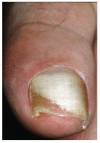Onychomycosis: A Review
- PMID: 29376897
- PMCID: PMC5770011
- DOI: 10.3390/jof1010030
Onychomycosis: A Review
Abstract
Onychomycosis is the most common nail infective disorder. It is caused mainly by anthropophilic dermatophytes, in particular by Trichophyton rubrum and T. mentagrophytes var. interdigitale. Yeasts, like Candida albicans and C. parapsilosis, and molds, like Aspergillus spp., represent the second cause of onychomycosis. The clinical suspect of onychomycosis should be confirmed my mycology. Onychoscopy is a new method that can help the physician, as in onychomycosis, it shows a typical fringed proximal margin. Treatment is chosen depending on the modality of nail invasion, fungus species and the number of affected nails. Oral treatments are often limited by drug interactions, while topical antifungal lacquers have less efficacy. A combination of both oral and systemic treatment is often the best choice.
Keywords: fungi; nail; nail lacquers; onychomycosis; systemic antifungal therapy.
Conflict of interest statement
The authors declare no conflict of interest.
Figures










References
-
- Scher R.K., Rich P., Pariser D., Elewski B. The epidemiology, etiology, and pathophysiology of onychomycosis. Semin. Cutan. Med. Surg. 2013;32:S2–S4. - PubMed
Publication types
LinkOut - more resources
Full Text Sources
Other Literature Sources
Miscellaneous

